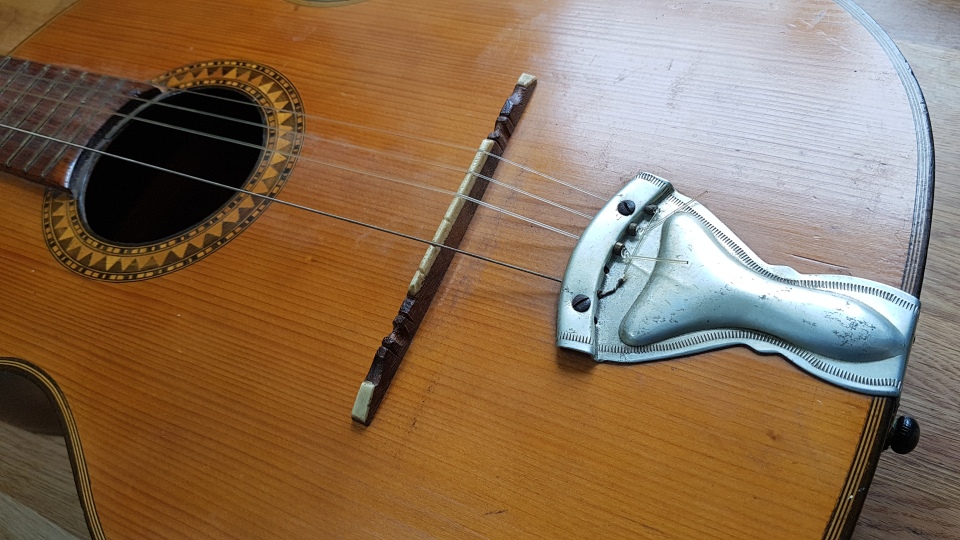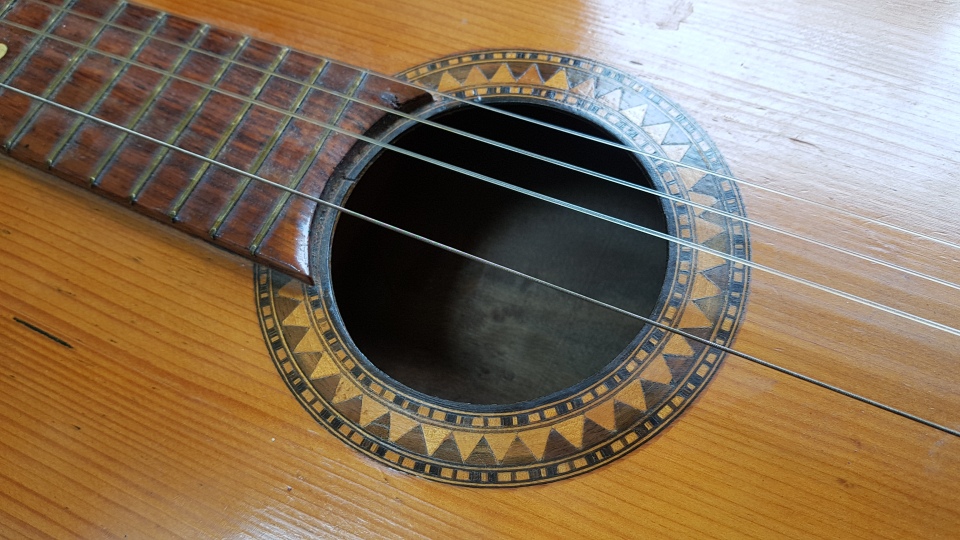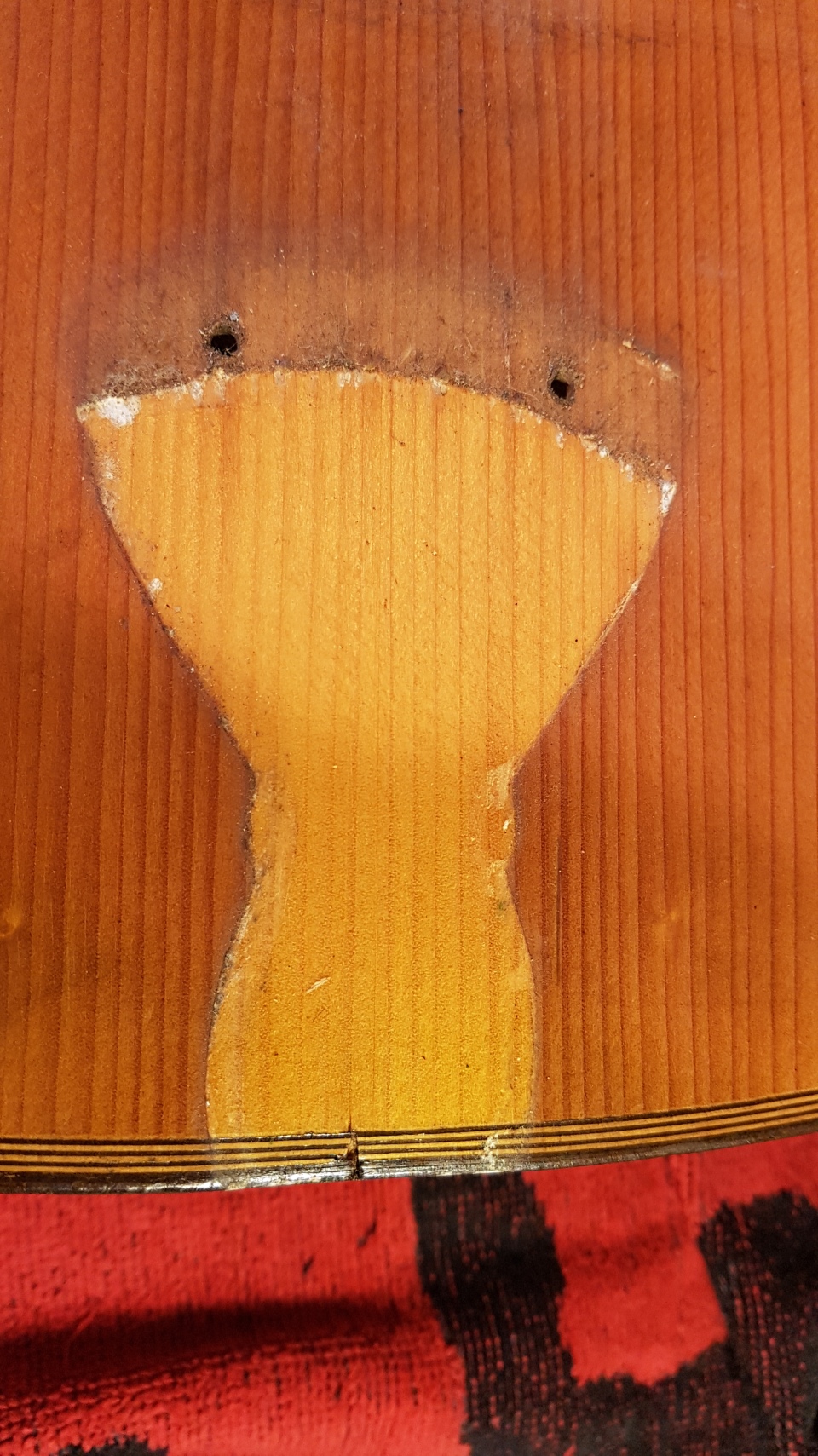A Personal Story of Old Wood Restoration – UPDATED


UPDATE: After I posted this piece I shared it on a couple of Facebook guitar groups. On the Parlor Acoustic Guitar Lovers Group one of the members, Mario Burgani, suggested that in fact the guitar might be Italian, made in Catania in Sicily. I’ve done some searching online and I think that he’s correct. Some of the features that I am seeing on Catania guitars on various websites are identical to mine, in particular the way the back of the guitar has been shaped to cover the heel of the neck, and the shape and design of the floating bridge, with the bone side pieces. My thanks to Mario for pointing this out.
I have now corrected the post and removed mentions of German manufacture.
This post IS about biodiversity, eventually, but I need to give some background first….
Guitar-based music is a big part of my life, and has been since my teens. However it wasn’t until I was about 20 that I first started playing guitar. That’s late, and I wish I’d begun earlier, but neither of my parents were musical and there wasn’t the influence or encouragement. It wasn’t until I finally left home for university, aged 22, that I started taking it in any way seriously and bought a half decent guitar (a 1986 Washburn D-12N, if you’re interested – I still have it and I’m very fond of it). Before I started my PhD, in 1989, I played quite a lot and was involved with the local music scene in Oxford, working stage crew for bands. It was a lot of fun and for a while I considered dropping my PhD and doing it full time. Some of the guys I worked with went on to become part of Radiohead’s crew and have had careers in the music industry. But, you know, life, kids, and science got in the way, the frequency of my playing became less and less, and for a long time I hardly picked up a guitar.
But in the past couple of years I’ve started to get back into it and am enjoying playing again. A few things have prompted this. The kids have all left home now, so I have more time. I’m finding it relaxes me and it’s a good way to get away from work and social media and screens. Also, there are many short “how to play” videos on YouTube, it’s like having a whole set of guitar tutors with different styles and approaches. It’s not just about the music though: I have a fascination with taking apart guitars and fiddling with them, which leads me on to the point of this post.
Back in late September I was looking at vintage acoustic guitars on eBay and salivating over the Martins that were for sale, when a guitar caught my eye. It was an old “parlour” guitar in pretty poor condition, and a steal at £50. Parlour guitars are small-bodied instruments that were popular in homes in the late 19th and early 20th centuries, before the guitars with big bodies, such as the Dreadnought models, became the vogue. They were the sorts of instruments used by early blues players – check out the photograph of Blind Lemon Jefferson on his Wikipedia page and you’ll see what I mean.
I was intrigued by the idea of having an old guitar with an authentic bluesy sound and also having a project to work on, restoring this instrument back to playable condition. The seller was based in Bedford, not far from Northampton, so Karin and I drove down there one Friday evening to pick it up.
Here’s a shot of the guitar as I bought it:

The body was sound and undamaged. The neck had a bit of a curve to it, but the brass frets were in good condition, though due to the fret board drying out over time their ends were protruding a little either side. However the bone nut at the top of the neck was broken, the pressed metal tailpiece was quite scratched, the tuning heads rusty and a little bent, plus there were a few other dings and dents. Here are some close-ups:

Someone has strung it with nylon strings which is probably not what was intended for this instrument. The point of a metal tailpiece like this is that it allows the guitar to have metal strings, which are under greater tension, without the need for more complex x-bracing under the soundboard to prevent it from warping or cracking:


It was clearly not the most expensive of guitars when it was first made, but the marquetry around the sound hole is in perfect condition and nicely executed:

There’s no manufacturer’s name or label in the guitar, no serial number or anything like that. So I did a little research online. It’s not the best quality guitar, as evidenced by the metal tailpiece which, as I mention, is designed to take the strain off the sound board when using metal strings. The alternative is to have a fixed bridge but that requires more elaborate (= expensive) bracing under the soundboard. However it’s clear that the guitar was handmade, probably in Sicily, by a local luthier, possibly in the 1920s, but certainly somewhere between 1900 and 1940: so it could be more than 100 years old.
The restoration of the guitar was fairly straightforward, the most complex part being the carving of a new bone nut from a blank that I bought online. The machine heads were removed, cleaned and oiled, then re-fitted; I could have replaced them but they were in decent condition given their age and I wanted to retain as much authenticity to the guitar as possible. The frets were filed and a neighbour who is a metal worker polished up the tailpiece. Most of the other work was fairly cosmetic – I didn’t want to touch the original finish.
Now we get to biodiversity. A lot of wood goes into the construction of acoustic guitars. In the case of this instrument, the soundboard is solid European spruce (Picea abies) that has aged to a beautiful golden colour. When I took off the tailpiece its original colour was revealed; that tailpiece has probably never been removed before:


That spruce top is book-matched: the two sides of the soundboard are symmetrical down the mid-line of the guitar, showing that they were split from the same board. Book-matching is a common technique used by luthiers, both for aesthetic reasons and because it’s harder to get a single piece of tonally-acceptable wood of that width. The tree from which it was cut was probably grown in a plantation; most old growth forest in Europe had been cut by the time this tree started growing. If you count the number of growth lines across one half of the soundboard there’s about 60, which gives an indication of the minimum age of the tree at harvest, i.e. it was at least 60 years old when it was felled. If the guitar was made in around 1925, and given that the wood from the tree would have to season for at least a couple of years, perhaps longer, before it was used, it means that the tree started growing some time in the mid-19th century. So the tree that contributed the soundboard has lived through summers and winters of profound historical change in Europe.
The sides, back and neck of the guitar are mahogany, as is the bridge I think. Nowadays “mahogany” can refer to a range of unrelated tropical trees – see this website for details. But when this guitar was made, mahogany usually referred to wood from species in the genus Swietenia, which naturally grow in Central and northern South America, and the Caribbean. So the tree that donated the wood was cut out of pristine, or at least long-established, tropical rainforest. One possible source is Belize which was exporting a lot of mahogany to Britain during this period, which may then have been exported all over Europe.
The fret board is probably Brazilian rosewood (Dalbergia nigra) judging by the black streaks or “spider webbing” in the timber. Brazil banned exports of the wood in the 1960s but there’s still much illegal harvesting going on of these and other trees. This species, and the three in the genus Swietenia, are in the IUCN categories “Vulnerable” or “Endangered” due to their over-exploitation, and are CITES-listed.
Some other, so far unidentified, woods were used in the construction of the guitar, in the marquetry around the sound hole, in the binding around the top, and in the end strap button. The latter may be ebony from one of several species in the genus Diospyros, which are likewise protected.
The wood used to make these old guitars is a legacy of an age when rapacious exploitation of the world’s natural resources was considered almost a public duty. There was little or no consideration for the ecosystems that were exploited, or how deforestation affected both wildlife and indigenous peoples. To some extent the situation has improved and there are global efforts to conserve the old growth forest that remains, albeit with variable results. But we are far from giving these forests the protection and restoration that they deserve. Modern guitar makers need to take responsibility for sourcing their materials ethically and sustainably, which some are and some are not. There’s a really interesting set of articles about this in the series Building a Sustainable Guitar at the Forest Legality website. At the other extreme the Gibson guitar company pleaded guilty in 2012 to knowingly using timber that was harvested illegally in Madagascar, a trade that Pete Lowry of the Missouri Botanical Garden is quoted as calling the “equivalent of Africa’s blood diamonds”.
Old musical instruments, furniture, and other artifacts have history as well as carbon locked into their timbers. Therefore I think that it’s incumbent upon us to cherish and use them and not consign the wood to the bonfire or to landfill. If that sounds too sentimental, then so be it. But there’s a practical side to this too: they are often better quality than more modern instruments and can be much cheaper.
All of my guitars have names that reflect something of their history. During the drive down to pick up the guitar from Bedford there was the most incredible rain storm, water lashing across the road and windscreen wipers on full blast. So I’ve named this guitar The Rainmaker. You can see the finished result of the restoration in the images at the top of this post. The results are pleasing, and I hope it lasts another 100 years at least.
One final thing: how does the guitar play and sound? As I said, the neck has a small curve to it and there’s no truss rod to adjust it. Re-setting it would be a major job. This means that the action (the distance between the strings and the frets) is very high, especially close to the body. So, I’ve tuned the guitar to an open E chord, have invested in a glass bottleneck, and am using it to learn to play blues slide guitar. And it sounds pretty good, with a warm, mellow, and (yes) bluesy sound.


